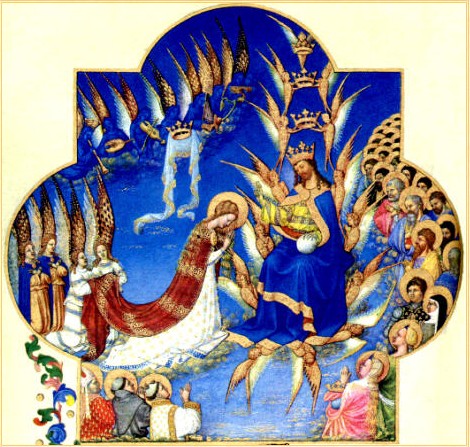
THE
GOLDEN
LEGEND
c. 1260
Jacobus de Voragine
Coronation of the B.V.M., Tres Riches Heures
|
|
Coronation of the B.V.M., Tres Riches Heures |
THE Golden Legend (Latin: Legenda Aurea) by Jacobus de Voragine (Jacopo da Varagine) is a collection of hagiographies (lives of the saints) and explanations of Catholic liturgies, Feasts, and doctrine that became a late mediaeval bestseller. It was probably compiled around 1260.
Initially titled simply Legenda Sanctorum, (“Legends of the Saints”), its popularity gained it the title by which it is best known. More than a thousand manuscript copies of the work survive, and when printing was invented in the 1450s, editions appeared quickly, not only in Latin, but also in every major European language. It was one of the first books William Caxton printed in the English language; Caxton’s version appeared in 1483.
THE book sought to compile traditional lore about all of the saints which were officially held up for veneration at the time of its compilation. De Voragine typically begins with a fanciful etymology for the saint’s name. An example (in Caxton’s translation) shows his method:
Silvester is said of sile or sol which is light, and of terra the earth, as who saith the light of the earth, that is of the church. Or Silvester is said of silvas and of trahens, that is to say he was drawing wild men and hard unto the faith. Or as it is said in glossario, Silvester is to say green, that is to wit, green in contemplation of heavenly things, and a toiler in labouring himself; he was umbrous or shadowous. That is to say he was cold and refrigate from all concupiscence of the flesh, full of boughs among the trees of heaven.
As a Latin author, de Voragine must have known that Silvester, a relatively common Latin name, simply meant “from the forest.” The “correct” derivation in modern eyes is alluded to in the text, but set out in parallel to fanciful ones that lexicographers would consider quite wide of the mark. Even the “correct” explanations (silvas, “forest”, and the mention of green boughs) are used as the basis for an allegorical interpretation. De Voragine’s etymologies had different goals from modern etymologies, and cannot be judged by the same standards. De Voragine’s etymologies have parallels in Isidore of Seville’s Etymologiae, in which linguistically accurate derivations are set out beside allegorical and figurative explanations.
De Voragine then moves on to the saint’s life, compiled with reference to the readings from the Roman Catholic Church’s liturgy commemorating that saint; then embellishes the biography with supernatural tales of incidents involving the saint’s life from less reliable sources. More than 130 sources have been identified for the tales related of the saints in the Golden Legend; in addition to the Bible, these sources include apocryphal texts such as the Gospel of Nicodemus, the histories of Gregory of Tours and John Cassian, and the Speculum historiale by Vincent de Beauvais. Many of his stories have no other known source.
Many of the stories also conclude with miracle tales from accounts of those who called upon that saint for aid or used the saint’s relics.
WRITTEN in simple, readable Latin, the book was read in its day for its stories... The book is the closest thing we have to an encyclopaedia of the lore of the saints in the late Middle Ages; as such it is invaluable to art historians and mediaevalists who seek to identify saints depicted in art by their deeds and attributes. Its repetitious nature is probably explained by the fact that de Voragine meant to write a compendium of saintly lore for sermons and preaching, not the popular entertainment it became.
IN his history of The Reformation, Diarmaid MacCulloch observed that the Golden Legend inadvertently may have helped trigger the Protestant Reformation by arming scepticism about the cult of the saints, such as that exhibited by Erasmus in his Praise of Folly. By compiling such a thorough vade-mecum of saintly wonderlore, showing highly similar stories being attached to different saints and relics, questioning readers could conclude that these tales circulated by local churches were probably mythical.
The critical edition of the Latin text has been edited by Giovanni Paolo Maggioni (Florence: SISMEL 1998]. Iacopo da Varazze: Legenda Aurea, ed. Giovanni Paolo Maggioni. Sismel: Florence Italy, 1998.
This Webpage was created for a workshop held at Saint Andrew's Abbey, Valyermo, California in 1990